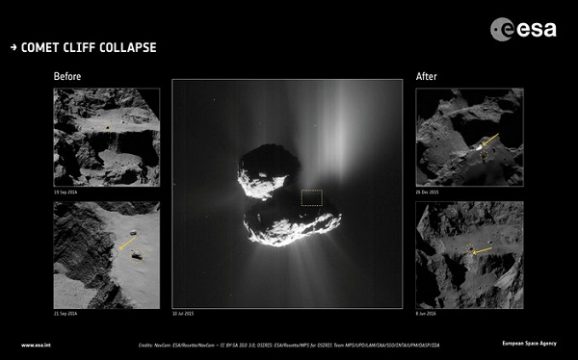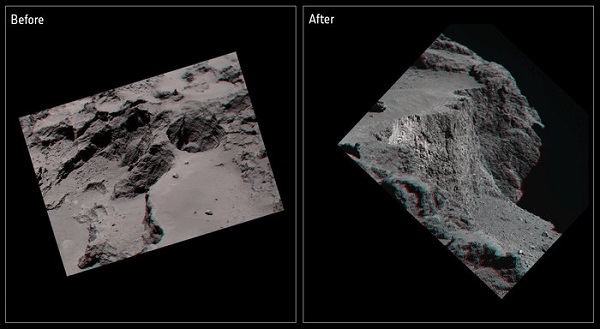Researchers have used data from the Rosetta mission to link outbursts on Comet 67P/Churyumov-Gerasimenko with dramatic surface changes.

ESA / Rosetta / Philae / CIVA
What's it like to ride along with a comet during a tumultuous pass near the Sun? Images from the late Rosetta spacecraft revealed just such a view, showing how the surface of Comet 67P/Churyumov-Gerasimenko has changed over time.
Comets are notorious for sudden outbursts as they near the Sun. Comets are even known for occasionally fragmenting as they approach the inner solar system. To date, the exact mechanism for such outbursts was poorly understood. Landslides were frequently evoked, though never witnessed.
On July 10, 2015, researchers got their chance, when Rosetta's navigation camera caught a large plume occurring on Comet 67P. Then, just five days later, Rosetta caught sight of a fresh, bright exposed escarpment in the Seth region of the comet along the 134-meter-high Aswan cliff. The albedo (reflectivity) of the exposed material was 40% (the same as dry sand), versus the murky 6% albedo for the old, dirty snowball surface of the comet.

The study was published last week in Nature Astronomy and provides insight into the first definitive link between an outburst on a comet and a change on its surface, in this case, the crumbling face of Aswan cliff. The newly exposed cliff face was six times brighter than the older surrounding material.
“One of the main aims of Rosetta was to examine how an active object like a comet works,” says Matt Taylor (ESA). “The observed changes from this perihelion passage do not describe large-scale erosion. This suggests that the comet had more active times earlier.”

ESA / Rosetta / MPS for OSIRIS Team MPS / UPD / LAM / IAA / SSO / INTA / UPM / DASP / IDA / M. Pajola
The team also made a visual count of the number of remaining boulders seen after the collapse at the bottom of the cliff and estimated that around 10,000 tons (for comparison, a modern U.S. Navy destroyer weighs in at about 9,200 tons) of material was involved in the landslide, with about 100 tons released in the resulting plume of gas and dust.
A Volatile Landscape

ESA / Rosetta / MPS for OSIRIS Team MPS / UPD / LAM / IAA / SSO / INTA / UPM / DASP / IDA; F. Scholten & F. Preusker
What's especially interesting to observers is the range of the debris seen in the landslide, ranging from 3 to 10 meters in size. This is consistent with particle distributions seen along the alien surface of Comet 67P.
Daily heating variations occur over the surface of the comet, peaking as it rotates once every 12 hours, but the Aswan collapse occurred at night. Clearly, researchers soon realized, seasonal variations in temperature play a role as well. These fractures may penetrate far down into volatile-rich layers, promoting a cumulative effect that weakened the cliff face. Keep in mind, too, that the surface gravity of a comet is very weak, making a landslide a slow-motion affair.
“It is difficult to correlate outbursts with particular changes, as we do not have continual coverage of the comet, and we were at a variety distances from the nucleus during the mission,” Taylor acknowledges. “However, we have been able to extrapolate large scales outbursts to particular regions and make the inference that there is a relation between them, the good example being the Aswan cliff collapse.”
Comet outbursts are not uncommon, but unpredictable by nature. We've seen outbursts from periodic comets such as 103/P Hartley 2, visited by NASA's EPOXI (formerly Deep Impact) mission in 2010. Comet 17P/Holmes provided the last great cometary outburst for amateur astronomers in 2007, and the currently brightening Comet 41P/Tuttle-Giacobini-Kresák is historically prone to the same as it nears perihelion next week on April 12. Interestingly, Arecibo radar also recently provided us with a look at another two-lobed comet, similar to Comet 67P, last month: 45P/Honda-Mrkos-Pajdu

USRA
Do outbursts on periodic comets differ from first-time, long-period visitors to the inner solar system? Unfortunately, this remains a difficult question to answer for two reasons: first, long-period comets (those with a period of greater than 200 years) show up with too little notice to mount a space mission. Second, long-period comets entering the inner solar system are relative fast movers, requiring lots of energy in terms of changes in velocity (known as Delta V) to reach.
This study is also a great example of how scientists are continuing to analyze data from Rosetta long after its demise last year.
The Story of Comet 67P . . . To Be Continued
The Rosetta mission has delivered an amazing bonanza of science, with data that will keep planetary scientists busy for years to come. Rosetta was able to track long-term changes as the comet neared perihelion on August 13, 2015, and was able to characterize its composition and interaction with the solar wind. Rosetta revealed that the deuterium-to-water ratio on Comet 67P is markedly different than what we see here on Earth. This finding is a strike against the idea that the primordial seas of the Earth were delivered mainly by comets. Rosetta also chronicled a speed-up of the comet's spin throughout perihelion by 21 minutes from 12.4 to 12 hours, most likely thanks to escaping gases.
Changes seen on the comet's surface provide researchers with the before and after “smoking gun” of seeing the possible triggering mechanism for a cometary outburst in action.

ESA / Rosetta / MPS for OSIRIS Team MPS / UPD / LAM / IAA / SSO / INTA / UPM / DASP / IDA
“It is difficult to predict what will be discovered, but when we ended operations, most teams had only looked at about 5 to 10% of their data.” Taylor says. “Now, scientists are focusing on more of the data, and they have been able to look at the comet data set as a whole.”
Though Rosetta fell silent on September, 30 2016, as it came to rest on Comet 67P, this study shows that we'll be enjoying science results from the fruits of its labor for years to come.
 0
0









Comments
You must be logged in to post a comment.